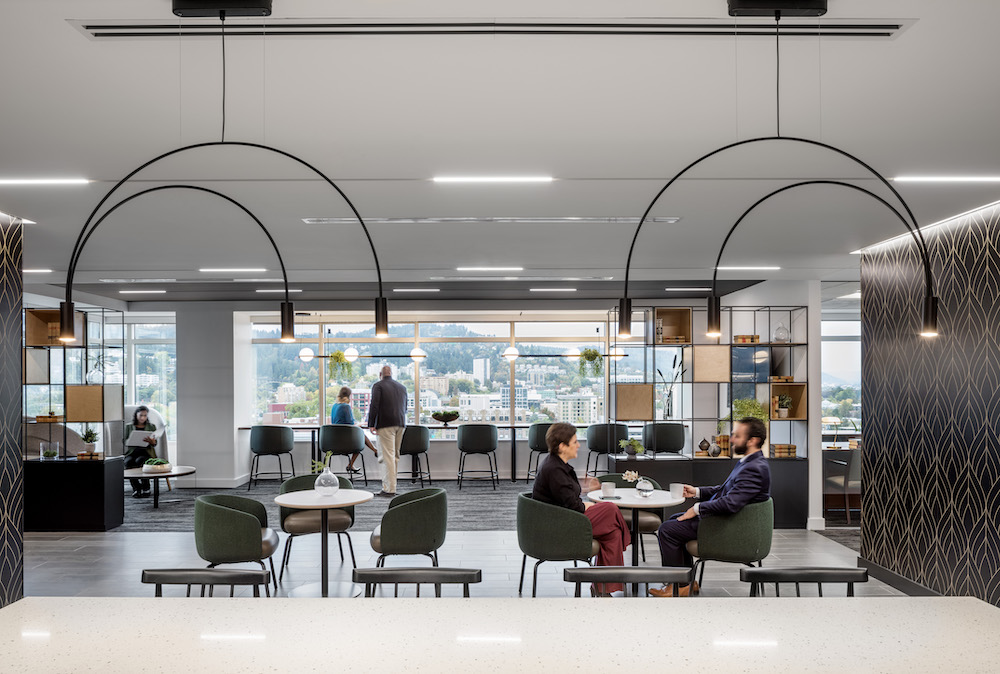Michael Stueve of Ankrom Moisan shares some of the ways people-first design can translate to the workplace.
With nearly 66% of the nation’s workforce working remotely, at least part-time, employees have become comfortable working within their home environment. But with the return to work on the rise, it’s going to take a lot more than flashy amenities and catered lunches to get employees back into the office.
Today, forward-thinking employers operate with a people-first design mindset—one that puts its employees’ needs at the forefront to create an inclusive and highly-tailored work experience. Now more than ever, employees are seeking individualized experiences and environments that allow them to have autonomy over how they choose to work. These personalized spaces will vary from person to person which is why it is important that they are designed with flexibility in mind. Some ways in which people-first design can translate to the workplace are by incorporating unique materialities, specifying body-appropriate furnishings, and integrating neuro-inclusive elements.

Specifying Office Furnishings and Fixtures
Within the workplace, not all employees and visitors react to the environment and furnishings the same. There is a medley of work styles and layouts that make each employee feel and work their best, and the office environment should be a safe space that considers those work styles and embraces diversity and inclusion.
To start, designers must take into consideration that within a workplace there are a variety of body types and sizes with different preferences. Some might like a stationary chair, while others prefer chairs that gently rock and swivel. Additionally, varying physical capabilities may require a chair with arms over one without an armrest, to help assist in getting up. Another example; while they are popular for their style and aesthetic, chairs that are quite low to the ground are inappropriate for most body types.

Incorporating Neuro-Inclusive Elements
Designers must also take into account those who are neurodiverse. About 15 to 20 percent of the world’s population is neurodiverse – and across the spectrum of neurological differences, individuals can react to certain elements or situations within a space that leads to the loss of productivity. This can be caused by an environment that causes distraction or overwhelms the senses.
When designers create new workplaces, they must be conscious of these differences to provide employees with a variety of spaces where they can be most productive. This may take the shape of small focus rooms with visual and acoustic privacy or even larger spaces with clear sight lines that are ready for robust collaboration. Providing ease of adjustability within spaces is also crucial to allow further personalization and create an even more comfortable visual, auditory, and tactile environment. This can include the addition of dimmer switches, temperature controls, and adjustable levels of visual and acoustic privacy. This idea also goes hand-in-hand with the fact that no one employee will have the same work style. Some employees might need to work in a setting where music is playing and can hear colleagues chatter in the distance while some need complete silence. Because of this, designers must provide employees with a choice of spaces in which to work. Whether it be an open seating space, cafe space, or single-occupant private room.

Incorporating the Senses
Experience-based design is another people-first design method that is customizable to suit each user’s preferences. Not only will this help to bring feet back through office doors, but it will also aid in employee productivity. Another way in which designers are curating these types of spaces is by creating an emphasis on sensory elements and the senses. This can include integrating a calming palette of neutral colors or incorporating soft textures. Some examples include:

- Sight: Studies have shown that color has the potential to affect mood, emotions, concentration, and even physical health. By integrating principles of color psychology into the workspace, there is a subconscious enhancement in the mindset of the employees.
- Touch: The integration of unique materiality and textured fabrics create an added level of comfort for employees. As we rise from the pandemic, a time when many were hesitant to touch anything, people are hungry for tactile sensation (ie. upholstery that you want to run your hands over, wall coverings that invite a quick brush, or draperies that you want to comb your fingers through).
Incorporating these elements requires research and feedback from the team who will be using the space. Just because one experience may work for one person, it may not work for another. Therefore, it is important that the space be flexible and tailored to the needs of the entire group.

Designing with Lighting in Mind
When designing an office layout, it’s important to consider daylighting. Studies have shown that providing daylit work environments offers a number of benefits including increased productivity levels and also improving sleep quality. It even helps workers when they leave the office too. Providing employees with exposure to natural light during the day helps regulate their internal sleep-wake schedules by syncing with their bodies’ circadian rhythm.
LED technology also plays a role in the overall employee experience. Aside from providing dimmable lighting, giving employees the option to change the colors within a work setting can help benefit employee productivity and mood. For example, warm lighting including tones of red and orange can help create a sense of comfort and relaxation while cool tones of blue and purple help boost alertness and reduce fatigue.


